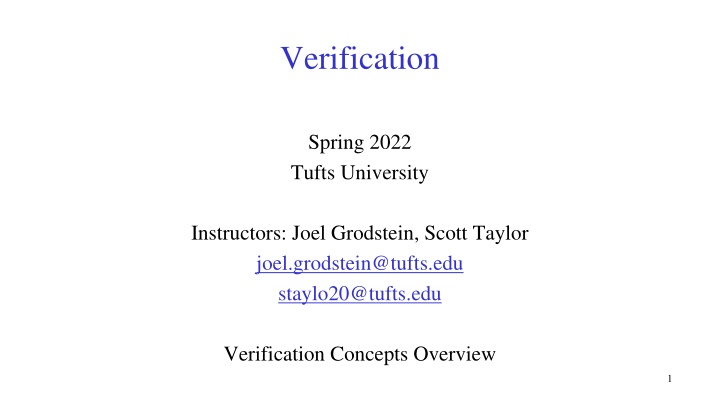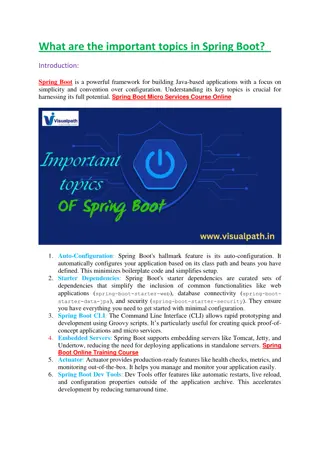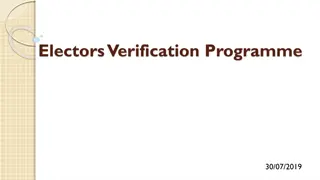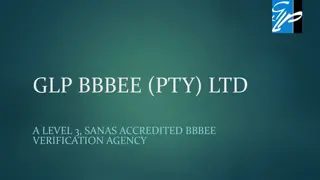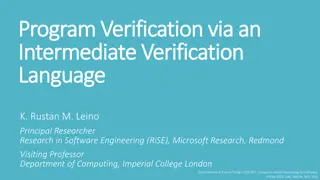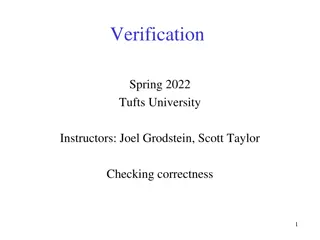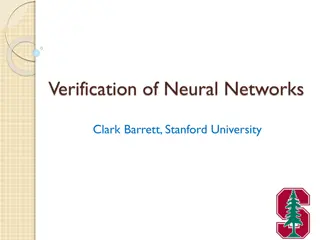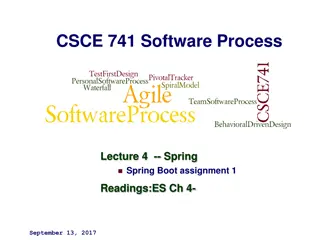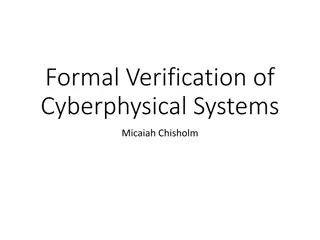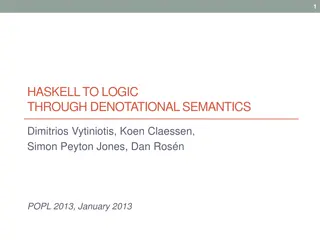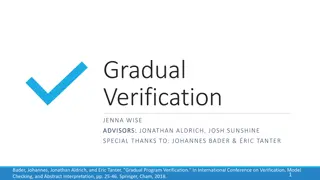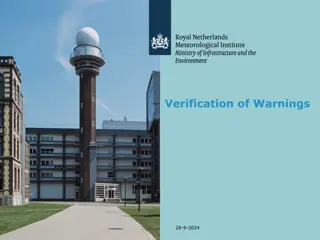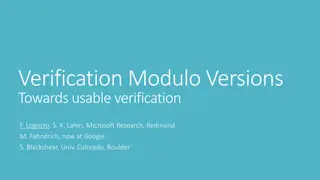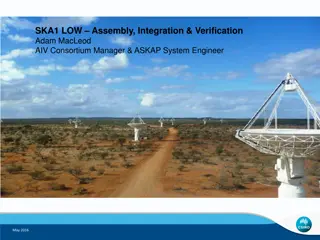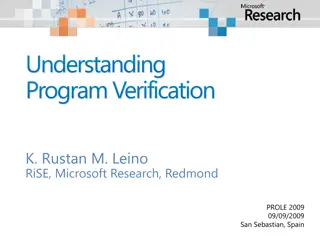Verification Concepts Overview for Spring 2022 at Tufts University
Learn about the verification process at Tufts University for Spring 2022, focusing on controllability, observability, testbenches, stimulus creation, and coverage to ensure thorough design verification. The importance of setting up inputs to control and observe the design is highlighted, emphasizing the need for comprehensive testing to validate the functionality of the Design Under Test (DUT).
Download Presentation

Please find below an Image/Link to download the presentation.
The content on the website is provided AS IS for your information and personal use only. It may not be sold, licensed, or shared on other websites without obtaining consent from the author.If you encounter any issues during the download, it is possible that the publisher has removed the file from their server.
You are allowed to download the files provided on this website for personal or commercial use, subject to the condition that they are used lawfully. All files are the property of their respective owners.
The content on the website is provided AS IS for your information and personal use only. It may not be sold, licensed, or shared on other websites without obtaining consent from the author.
E N D
Presentation Transcript
Verification Spring 2022 Tufts University Instructors: Joel Grodstein, Scott Taylor joel.grodstein@tufts.edu staylo20@tufts.edu Verification Concepts Overview 1
The Big Picture Learn the design by reading specs, talking to the designer, etc. Define a plan for completely testing the design (the Test Plan ). This informs all the remaining steps in the process! Create a testbench that implements the hooks for controlling the design and observing its behavior Create stimulus that drives the DUT and causes interesting behavior Create checkers that look at the observed behavior to determine if it is behaving properly Create coverage to confirm that you are fully exercising the design Iterate until you have fully verified the design 2
Agenda Controllability and Observability Testbenches Stimulus Checking Coverage 3
Brainstorm: Controlling and observing Given the circuit below, how would you set up and time the inputs so that you set the node test to 1 test if it indeed was set correctly by looking only at out2 (a cycle later) Assume that all flops clock from the same clock a1 a0 D Q test test2 D Q b1 b0 D Q out2 bc1 c1 c0 D Q D Q de2 d1 d0 de1 D Q e1 e0 D Q 4
What is Controllability? In order to test a design, you must be able to control it Control means the ability to manipulate the design s inputs to cause the Design Under Test (DUT) to do what you want In verification, the goal is to fully exercise ALL of the logic in the DUT in some meaningful way (not just the final external outputs) If you haven t tested it, it s broken Exercising the logic is easy for simple combinatorial logic, but complex sequential logic requires varying the stimulus over time to get the internal state to the desired endpoint. Modern processors are so complicated that it is virtually impossible to verify them by only looking at the chip s primary inputs and outputs 5
Controllability examples Combinatorial: A must be true in order to have B (or C) propagate to D Path sensitization D might be something deep in the middle of the design A D B C Wait for REQ CMD = RD IDLE REQUEST Sequential State Machine must be in REQ state in order to send CMD RESPONSE WAIT Until ACK=1 DATA=0xABCD 6
Types of Controllability Direct control of individual primary input/output pins of the DUT Drive reset=1 for 3 cycles Drive a 1.67GHz clock input for the duration of the simulation Bus Functional Model Mimics a higher abstraction such as a bus protocol, I/O device, or the behavior of another piece of the design PCIE Main Memory Interrupt controller Jamming/Forcing internal design nodes to override RTL behavior Perhaps to test a bug fix Perhaps to inject errors (Parity, DMA, bus corruption, etc) 7
Brainstorm: Cache preload One feature that most CPU testbenches support is cache preload i.e., the ability for the verification environment to directly stuff binary instructions into a CPU s ICache why might this be so important? 8
What is Observability? Once you have caused the DUT to do something interesting , how do you know what it actually did? To observe is to have some part of your simulation environment that wraps around the DUT (the Testbench ) able to see key behaviors of the DUT. This is typically called a monitor . If you can t see it, it s broken Note: Observability is only the ability to SEE the results. It doesn t say whether those results are CORRECT! That s a Checker and is different from a monitor . Observability feeds the checkers, and it s sometimes hard to separate the two. 9
Observability examples Core does a write to a cache line. How do you know whether it got there correctly? Something has to either look at the data, or depend on it for proper operation You re trying to cause a branch mispredict to see if instructions executing in the shadow of the branch inadvertently update architectural state. How do you know if you got the intended branch misprediction? How do you know if an error condition occurred? How do you tell if a bus transaction completed successfully? Did the frame buffer for the current screen redraw contain the correct set of image data? 10
Types of Observability Direct Have your testbench look directly at a signal or signals. These could be the primary outputs, or could be a purely internal signal Indirect Ensure (via controllability!) that the desired state causes the design to behave differentlyin the good and bad cases, and then look at that downstream behavior to infer whether your target signal did the right thing For the Did we write the cache line example, you could Read the data back and branch to pass/fail based on the result (indirect) Use the testbench to poke directly into the cache signals to see if the data is present (direct) 11
Brainstorm: Observability In the previous example of do a program read of the data to see if the data was a hit . Why won t this work?? What might you be able to do/enhance to resolve the issue? 12
Breaking down the design A full chip is generally too complicated to test as a single monolithic unit Too slow to simulate Too complicated to control the deep internals Too hard to force every signal behavior to be visible at the external pins to determine pass/fail Therefore, we typically divide and conquer the design by breaking it into manageable pieces (units) Each piece can be individually tested, and then more limited testing done at the full chip level to exercise interactions BETWEEN the pieces There can be MULTIPLE layers of pieces that all build up to the full design! Multiple units can be combined into a larger integrated unit, and so on 13
SOC Primary inputs might be Clock oscillator Reset DRAM PCI HDMI Memory Controller CPU PCIE Coherency Engine GPU Display How do you fully test CPU, GPU, etc using only those interfaces?? Camera Codec Misc 14
CPU Here, we have some more controllability and interfaces that are closer to the logic. We don t have to worry about configuring units that aren t present (simplifies our modeling) However, still difficult to control the behavior of a single unit within the CPU Interrupt CTL Caches Local Coherency CTL Exe Cores Cores Exe 15
Core Smaller amount of logic to control; better control over a single core than a whole CPU containing multiple cores and a shared cache Reg Files Fetch/Decode Floating Pt Integer LD/ST unit 16
Integer Unit Here we have direct control over individual opcodes and register values Small amount of logic means very fast simulations Easy to control and observe Integer Exe 17
Controlling and observing Consider the examples in slides 12-15. Assume that in slide 12, you are trying to test the GPU in each of slides 13-15, you are trying to test the integer unit of one core For each of these four cases what would you drive to control the test? how would you observe the results? 18
Benefits and disadvantages of unit vs integration levels Unit-level testing Pros Easy to control Faster Easy for one person to hold it all in their head Cons Many assumptions on how the other units behave Must model those other unit behaviors Can t fully test interactions Integration-level testing Pros More of the logic is real Can test interactions between internal units Cons Harder to control behaviors between units Slower Usually involves multiple people due to size of design 19
Agenda Controllability and Observability Testbenches Stimulus Checking Coverage 20
Testbenches Depending on what level of unit/integration you choose, you need to create a testbench that will drive the primary inputs of that DUT and observe the outputs. This is called the testbench . A testbench is the set of components that implement your stimulus, checking, and coverage. You don t want too MANY levels of units/hierarchies, as that is more work to create unique components for each layer But you don t want too FEW levels, either, as that makes it harder to fully test each one. It s a balance! Ideally you want to re-use components between layers that share a functional unit or interface (don t re-invent the wheel!) 21
Example unit testbench Stimulus Checking Clock Driver Reset Driver Test and Debug interface driver Interrupt driver Reset Rules Power Mgmt Quiescence DUT (single CPU Core) Memory Coherency Performance Other Coverage All Mem Req types Mem Rsp types Mem/Cache preloader Control Register I/F Opcodes Clock freq End of Sim detection CTL Reg modes 22
Brainstorm: Testbenches Given the previous slide, what might change if the DUT was changed to be: The full SOC? Just an integer unit? Just a cache and its control logic? 23
Agenda Controllability and Observability Testbenches Stimulus Checking Coverage 24
Stimulus Stimulus is the method by which you provide controllability Stimulus can take many forms, depending on the DUT. It consists of one or more items: A program (instruction stream) or sequence of commands Memory contents (data stream) that are to be consumed or operated upon Side instructions to a BFM (perhaps to cause interrupts at a specific time) Direct forces of primary inputs (clocks, resets) at a specific moment Direct forces of internal nodes (configuration registers, parity bits, driving X values) When you plan your verification, you need to determine what kinds of stimulus are needed (and where) in order to fully explore your design! 25
Types of stimulus Hard coded ( Directed testing ) E.g. text file with a list of specific transactions to send and at what times Random Purely random is rarely used (think of a program with completely random bits!) Pseudo-random(or Directed random , or Constrained random ) is prevalent Choose 40% reads and 60% writes for the command field Stimulus can be independent of DUT state, or can be reactive Independent: send a series of random values for the texture map Reactive: If core11 is within three cycles of entering a powerdown state, send a snoop request 5% of the time Discuss: Why is that specific timing relationship interesting? Think back to previous lecture on design interactions! 26
Agenda Controllability and Observability Testbenches Stimulus Checking Coverage 27
Checking Checking is one of the forms of observability Checkers implement a set of RULES that the design must obey. Checkers define the expected behavior of some part of the design Legal and illegal outputs Checkers usually consume internal RTL state or primary outputs Checkers need to know the right answer somehow (more on this in a future lecture!) Checkers need to know when it s VALID to do the check Is it true for all times? Or is it only true under certain conditions? Checks can be narrow (single signal) or broad (overall behavior of an entire functional unit) 28
Types of Checking Design assertions within the design RTL for simple relationships Illegal encodings Testbench objects (Checkers) that look at a specific signal, interface, or functional unit, and confirm the proper behavior is occurring Checkers can look for correct values at a point in time Data should be 0x1234 for the current request Checkers can look for consistency between two different signals If valid=1, then cmd must be one of 5 valid encodings 29
Types of Checking Checkers can look for illegal behaviors No invalid opcodes No parity errors are expected in this test (but might be expected for a DIFFERENT test!) Clock must always have a 50% duty cycle (No glitches or runt pulses ) Checkers can look for more abstract expected behaviors A new cache request to index A should cause an eviction of any dirty data in index A A power management request to the C7 state should ultimately result in removal of power to the requesting core At the end of a test, all queues and FIFOs must be empty and all credits at their max values ( quiescence ) Checkers can look for the LACK of a behavior Didn t detect error Didn t respond in the allowed timeframe 30
Where do we get ideas for checker rules? General analysis/knowledge of the design will reveal some obvious rules FIFOs should process entries in a specific defined order A block shouldn t produce any transactions if its clock is supposed to be gated The various design specifications will provide others PCIE protocol rules (architectural spec) Credit/debit rules on number of outstanding requests allowed (microarchitectural spec) Memory Coherency rules (MESI, etc) As you write the test plan for your block, you capture all these rules and then decide HOW they will be checked 31
Agenda Controllability and Observability Testbenches Stimulus Checking Coverage 32
Coverage Coverage is another form of observability Coverage is a way of determining if certain events have or haven t occurred These could be individual events, or sequences of events over time Coverage gives an idea of how good your stimulus of the design is. Coverage can tell you when there are holes in your verification plan Coverage can be measured for a single testcase, but is more often aggregated across many simulations to get a better idea of overall design and testcase quality 33
Types of Coverage RTL coverage Line coverage (tells whether each line of RTL has been executed) Toggle coverage (tells whether each signal in the RTL has had a 0->1 transition as well as a 1->0 transition Condition coverage (tells whether conditional logic has executed both sides of the condition) Functional coverage More abstract; implies some design knowledge All possible (legal) values for an encoding Sequences of events (Back to back transactions with the same address) Finite State Machine (FSM) coverage Did we enter all legal states? Did we transition via all legal arcs? 34
